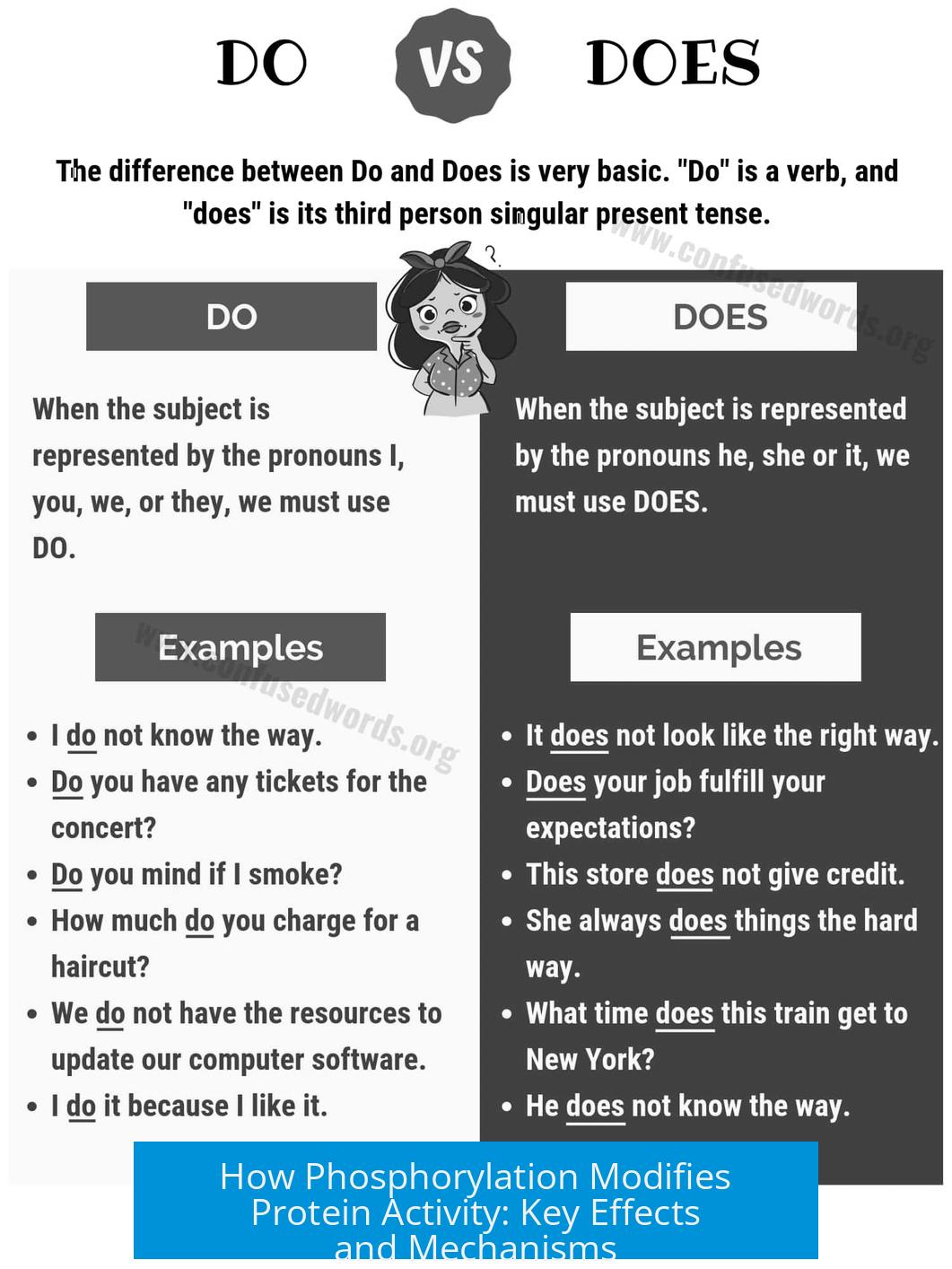How Does Phosphorylation Alter Protein Activity?
Phosphorylation alters protein activity by adding a negatively charged phosphate group to specific amino acids (serine, threonine, or tyrosine), which causes structural changes and modulates protein interactions, leading to activation, inhibition, or relocation of proteins within the cell.
Biochemical Basis of Phosphorylation on Protein Function
Phosphorylation modifies protein behavior through changes at the molecular level. When a phosphate group attaches to amino acids like serine, threonine, or tyrosine, it shifts their charge from neutral to a negative state, typically −2 or −3. This substantial addition of charge disrupts existing interactions and forms new ones.
- Previously, amino acids might engage in hydrophobic interactions; phosphorylation disrupts these due to the introduction of a charged group.
- The phosphate group enables new hydrogen bonds and electrostatic interactions with other protein regions or molecules.
- Such changes may induce dramatic intramolecular conformational shifts, opening active sites or altering the protein’s functional domain accessibility.
For example, kinases often contain activation loops that remain inactive until phosphorylated, which relieves self-inhibition and activates enzymatic function.
Phosphorylation Creates New Interaction Platforms
Phosphorylated residues serve as docking sites for proteins carrying specific recognition domains such as SH2 (Src Homology 2) or PTB (Phosphotyrosine-Binding) domains. This enables assembly of protein complexes essential for signaling pathways.
Since amino acids susceptible to phosphorylation are neutral, adding a phosphate creates a new negatively charged site primed for electrostatic interaction. This acts as a “handle” for other proteins, fostering selective recognition that modulates downstream effects.
Functional Effects of Phosphorylation on Proteins
The biochemical shifts from phosphorylation translate into functional changes:
- Activation or Inhibition: Phosphorylation can activate enzymes by exposing the active site or removing inhibitory structures. Conversely, it can inhibit activity by altering shape to block substrate binding.
- Signal Transduction: Phosphorylation is pivotal in cell signaling cascades, transmitting external signals by sequentially modifying multiple proteins for a cellular response.
- Protein Localization: Phosphorylation often dictates where a protein resides inside the cell, directing them to membranes, organelles, or cytosolic compartments.
- Protein-Protein Interaction Scaffolds: It may promote or disrupt interactions with other proteins, influencing the assembly of multi-protein complexes.
- Phase Separation Changes: Phosphorylation can modulate liquid-liquid phase separation, affecting intracellular organization and compartmentalization.
Evolutionary and Cellular Context of Phosphorylation
Phosphorylation relies on ATP as a phosphate donor, a molecule abundant inside healthy cells. This availability ensures kinases have steady access to phosphate groups, pushing reaction equilibrium towards phosphorylated products.
| Modifier | Abundance in Cells | Impact on Protein Regulation |
|---|---|---|
| Phosphorylation (ATP) | High; millimolar concentrations | Widely used for fast, reversible on/off switching |
| Acetylation (Acetyl CoA) | Lower; ~10x less abundant than ATP | Less common, slower regulation |
ATP’s solubility and diffusibility make it an ideal substrate for phosphorylation. Unlike acetyl CoA, ATP freely diffuses in the cytoplasm, enabling rapid regulation. The phosphate bond remains stable at physiological pH, securing that phosphorylated states are maintained until enzymatically reversed.
Evolution leverages phosphorylation extensively due to:
- The constant availability of ATP in cells.
- The biochemical stability of phosphate attachment.
- The capacity to enable swift and reversible functional switches.
- Reuse of this mechanism across life forms for controlling numerous cellular processes.
Phosphorylation as a Regulatory Switch
Phosphorylation acts as a molecular switch by changing the protein’s conformation and interaction capability. It may activate an inactive enzyme or inhibit an active one. This switch governs pathways including cell growth, metabolism, and response to environmental signals.
Protein kinases catalyze the addition of phosphate groups, whereas phosphatases remove them, generating dynamic control over the protein function. This interplay provides precise temporal and spatial regulation.
Summary: Key Takeaways on Phosphorylation and Protein Activity
- Phosphorylation introduces large negative charges to specific amino acids, altering protein structure and interaction potential.
- It disrupts existing hydrophobic interactions and creates novel hydrogen bonds and electrostatic contacts.
- Proteins change shape upon phosphorylation, exposing or hiding active sites to regulate activity.
- Phosphorylated residues serve as binding platforms for proteins with domains like SH2/PTB, enhancing signaling complexity.
- The high cellular ATP concentration ensures efficient and stable phosphorylation reactions.
- Phosphorylation’s reversibility underlies cellular on/off switches central to regulation and signal transduction.
- This modification is evolutionarily favored due to its biochemical properties and cellular accessibility.
What molecular changes occur in a protein upon phosphorylation?
Phosphorylation adds a negative charge to specific amino acids like Ser, Thr, or Tyr. This disrupts previous hydrophobic interactions and enables new hydrogen bonds and electrostatic interactions, altering the protein’s shape and interaction potential.
How does phosphorylation activate or inhibit protein function?
Phosphorylation can cause conformational changes that open active sites or remove self-inhibition. For example, some kinases require phosphorylation of an activation loop to become active, directly changing the protein’s function.
Why is phosphorylation a preferred regulatory mechanism in cells?
Cells have high ATP levels, making phosphorylation easy to achieve. The phosphate bond is stable, allowing reliable on-off switching of protein activity. Evolution reuses this mechanism widely across species due to these advantages.
How does phosphorylation influence protein interactions within the cell?
Phosphorylated sites create charged regions that serve as docking sites for proteins with specific domains like SH2 or PTB. This fosters new protein-protein interactions and can localize proteins to specific cellular regions.
Can phosphorylation affect cellular processes beyond individual protein function?
Yes, phosphorylation can alter signal transduction pathways and impact liquid-liquid phase separation. These effects extend the influence of phosphorylation from single proteins to broader cellular activities.





Leave a Comment